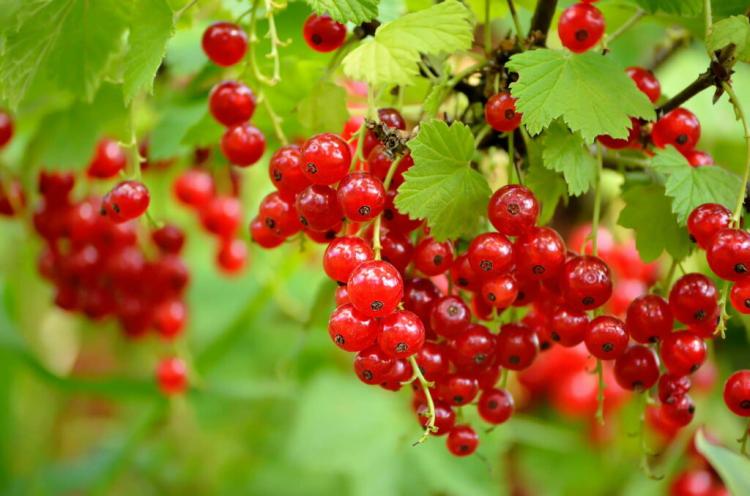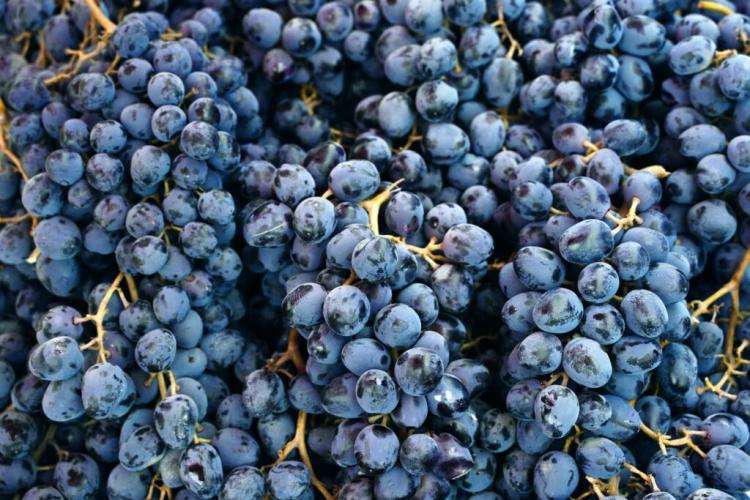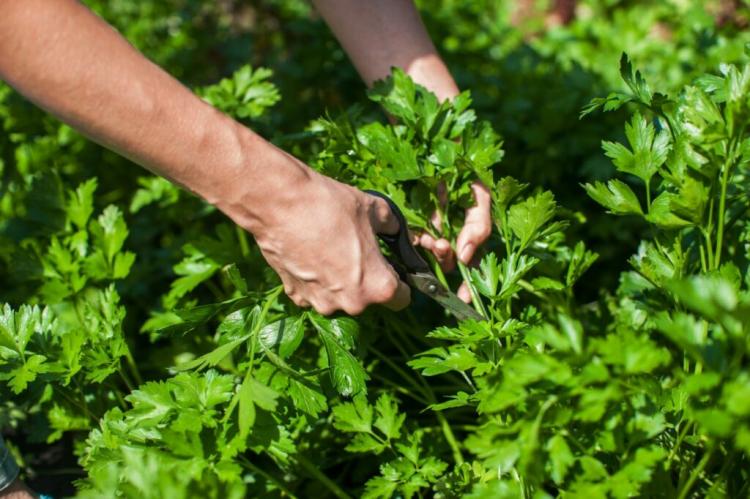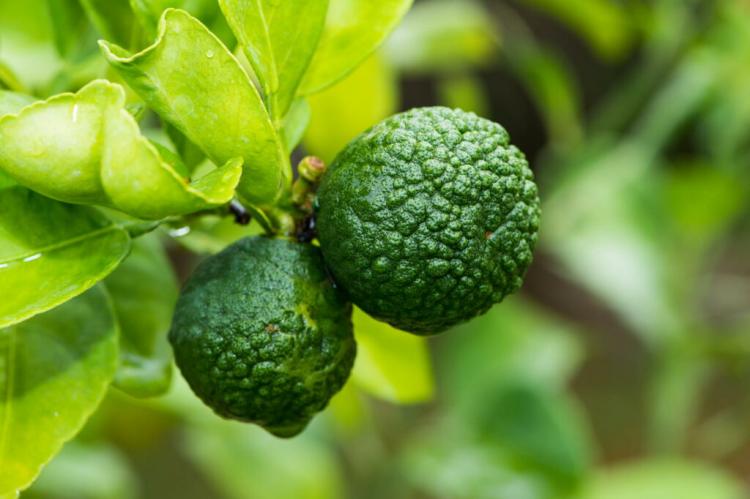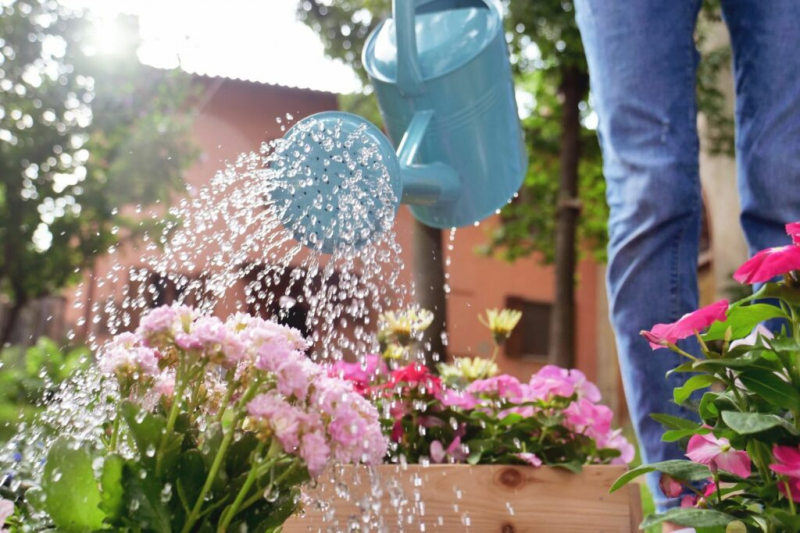Currants: Everything From Planting To Harvest
Currants should not be missing in any garden. Here you can find out what needs to be considered when planting, caring for, and harvesting.
Growing currants ( Ribes ) in your own garden is worthwhile for several reasons: they are rarely available in the supermarket or even at the weekly market and if they do, the quality often leaves a lot to be desired. However, currants taste best fresh – then their valuable vitamin C has not yet evaporated. In addition, currants really don’t do a lot of work and make us happy for many years. We’ll tell you how to plant currants correctly and what you need to consider when cutting, fertilizing, and the like.
Currants: characteristics and origin
Table of Contents
Currants are part of the gooseberry family and originally come from Central and Northeastern Europe. Its name probably comes from St. John, whose name day falls on June 24th and thus roughly coincides with the ripening of the currants. The deciduous shrubs reach a height of one to a maximum of two meters, depending on the variety.

The berries, which can be harvested between June and August depending on the variety, grow on grapes. Compared to raspberries ( Rubus idaeus, aggregate drupes ) or strawberries ( Fragaria, aggregate fruits), the fruits of the white ( Ribes Sativa ), red (Ribes robust), and also the blackcurrant ( Ribes nigrum ) are real berries.
Currant species and varieties: overview
Currants are distinguished by their color – so there are red, white, and black specimens. The different colored currants vary in their ingredients and therefore also in taste. Below is a brief overview of the different types of currant, as well as some of the best varieties of each.
- Red currants: Highest content of fruit acids compared to white and black currants; Taste usually sweet and sour to sour; are consumed fresh, as juice, jam or as cake; the best varieties are a matter of taste – we recommend, for example, ‘Jonkheer van Tets’ and ‘Rotet’.
- White currants: they are somewhat milder and sweeter than red currants; much appreciated for processing into berry wine; proven varieties are, for example, ‘White Versailler’, ‘Primus’ and ‘Witte von Huisman.
- Black currants: they are less likely to be eaten fresh, although they contain five times as much vitamin C as white or red currants; Because of their bitter taste, they are often made into jellies, juices, or dessert wines; We have had very good experiences with the ‘Bona’ and ‘Ometa’ varieties in the garden.

There are also currants ( Ribes sanguine ). However, these are grown as ornamental plants and not for consumption. Your few fruits have hardly any aroma. While they are not poisonous, they are not suitable for consumption. Because of their beautiful spring blooms, blood currants are still popular. For example, ‘Snowflame’ is a nice strain.
We have compiled a larger overview of propagating current here.
Buy currants or propagate them yourself?
Currant bushes can be purchased in hardware stores, garden shops, and also on the Internet. If you don’t want to buy new plants, you can also propagate your currant plants yourself. However, you will need a little patience until the delicious fruits are harvested for the first time.
Buying currants: this is important to note
If you choose healthy plants of a robust, rainproof variety when buying currants, you can save yourself a lot of work later. Because as a rule, these plants are attacked by diseases less often. In principle, it is worthwhile to think about which current varieties are suitable for your own garden before buying. After all, there are many criteria to consider, from taste to harvest time, fruit size or color to resistance to various diseases.
You might so like: Lovage Plants: Cultivation Of The Maggikraut In Pot And Bed
Propagate currants yourself
The easiest way to propagate currants yourself is by cuttings. The mother plant is practically cloned, so the cuttings belong to the same variety as the mother plant. Correctly, these are more cuttings, as the shoots for propagation are usually much more lignified than herbaceous cuttings.

The propagation of currants with cuttings in a nutshell:
- Cut 20 cm long cuttings with at least 2 – 3 eyes
- Prepare a nutrient-rich, humus-rich growing bed or pot
- Insert cuttings so that at least 2 eyes still look out of the earth; make sure that the buds point upwards
- Water sufficiently and keep moist for a few weeks
- When the first shoots are 5 – 10 cm tall, the tips of the shoots are cut off
- After 6 – 12 months, transplant to a larger pot or its final location
- First harvest around 3 years
Planting currants: timing and procedure
Below you will find all the important information on how to successfully grow currants in your garden.
Currants: the right location
Currant plants prefer slightly acidic, medium-heavy, and humus-rich soil. Since they are forest and swamp plants, they also need uniformly moist soil. To better ensure this, they are often covered with a layer of mulch, for example with grass clippings, manure, or bark mulch. This layer of mulch also protects the roots of the plant from frosts in winter.
Currants feel at home in this location:
- Sunny to partial shade (for partial shade we recommend white currants)
- Soil doesn’t have to be deep; a large plant trough or a low bed (40 cm) are therefore sufficient
- In severe frosts and when there is a high risk of late frost, mobile plant troughs and pots are the better choices; if there is a risk of frost, for example, push them into the garage or carry them
- Soil should be able to hold moisture well; medium-heavy soil is therefore ideal
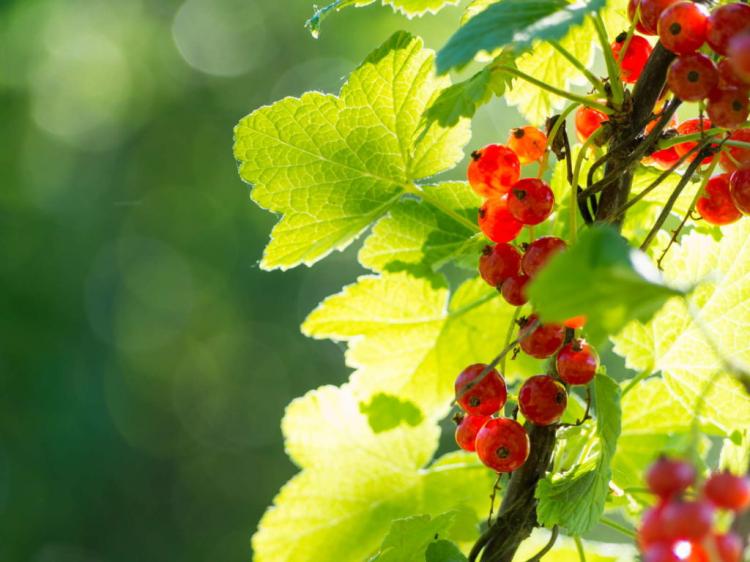
Currants: when is the best time to plant?
Currants root best if you plant them in autumn after the leaves have fallen or in early spring before they sprout again. At this point, the soil is usually well moistened, the water requirement of the plants that have not yet sprout is significantly lower and the risk that the young, poorly rooted plants will dry out is lower. In principle, however, planting is possible almost all year round. In this case, you should only pay attention to a good water supply after planting.
You might so like: Rose Care: Everything You Need To Know From Fertilizing To Cutting
Planting currants: instructions
Planting currants works basically the same as other berry bushes or fruit trees. The only difference you should be aware of is that the plants have to be placed a little deeper – red and white currants a few inches and black currants even a hand’s breadth. This promotes the development of new young shoots, which is particularly important with black currants, as these only bear fruit on the annual shoots.
Planting currants – this is how you do it step by step:
- Clear the soil of weeds so that they do not grow into the rootstock afterward.
- Dig a planting hole and loosen the soil next to and underneath with a digging fork.
- The strongest and most beautiful five to six shots, which grow in different directions if possible, are selected and cut back to a third of their length. However, there should still be three to five buds per shoot. Cut off the remaining shoots.
- Dip the root ball briefly in water so that it soaks up with it.
- Place red and white currants in the planting hole a few centimeters deeper than originally and black currants a hand’s breadth deeper than before in the pot.
- Fill the planting hole with compost soil, press the soil lightly and pour generously.
- Cover the soil surface with mulch (bark mulch in the case of lime-rich soils, grass clippings, straw, manure, etc.).

Important for tall trunks: Before planting, a stake is knocked into the planting hole, to which the tall trunk is attached after planting. Incidentally, even after a few years, the stems bear far fewer currants on average than a well-developed bush. So here you have to decide between optics and yield. In addition, tall trunks also need to be cut thicker and more regularly so that they keep a nice shape. So you prepare a little more work.
You might so like: Grow Horseradish: The Pungent Root In Your Garden
Transplant currants
When transplanting currants, it is important to consider the age of the plant. After transplanting, it takes two to three years for the shrub to fully recover and hopefully bear as many berries as before. Such an approach is therefore only worthwhile for younger shrubs. The best time to transplant is autumn. The soil then dries out less quickly and the roots, which first have to anchor themselves again in the soil, find enough water.
The procedure is very similar to that of planting currants, but you should also lightly prune the roots of the currants when transplanting. The planting hole should be dug out generously and should also be extensive when digging out. You cut a circle around the plant that is larger than the bush diameter with the spade and try to loosen the soil as deep as possible under the bush with a digging fork. Then dig up the current plant and cut the damaged roots back to the healthy tissue. Now move the plant to its new place and generously fill the planting hole with compost.
Water and fertilize currants
Currants do not have deep roots, but prefer moist soil that rarely dries out – and if so, not for too long. This places very special demands on your water supply. We will give you tips and at the same time tell you what is important when it comes to the right nutrient supply for currants.
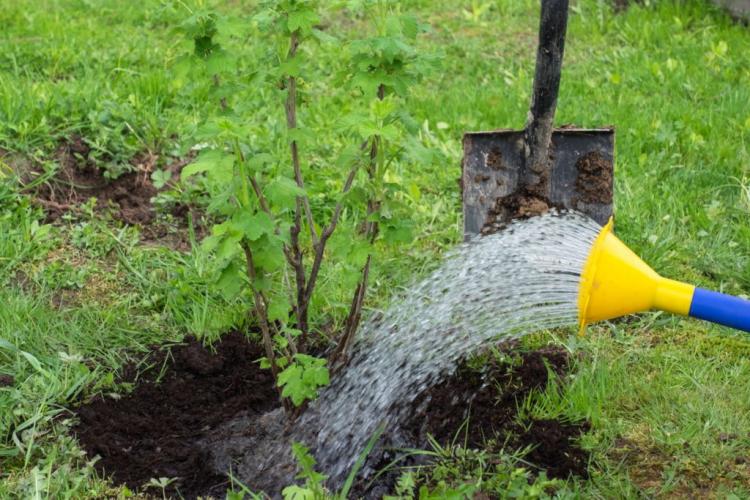
Pour currants properly
Currant bushes want to be adequately watered, especially in the warm and dry summer months. Since the roots of many varieties do not penetrate very deeply into the soil, regular watering is essential if there is no rain. The frequency and amount of watering are highly dependent on the soil conditions. As a general rule: Due to the better water storage, currants do not have to be watered as often on heavy, rather loamy soils as in sandy locations.
Incidentally, the water requirement of every plant is highest during flowering and fruiting, but in the time in between, there should not be longer drying times. So after the harvest, you usually don’t have to worry about your currants anymore. If it rains very little in autumn, the plants look forward to a little extra water every few weeks, but in regular autumn with occasional rainfall, the low water requirement at this time is well met.
Our tip: The mulching of currant bushes – for example with straw, grass clippings, or bark mulch – reduces the evaporation of the soil water and thus keeps the plants more humid. But be aware of the consequences that mulch materials such as straw and bark mulch have for the supply of nutrients to your plants.
You might so like: Nasturtium Flowers: The Uncomplicated Exotic
Fertilize currants properly
Currants are best fertilized in February. An organic fertilizer, which gradually unfolds its effect, provides the currants with many nutrients over a long period of time from early spring, when the shoots begin to grow, through to fruit formation. Because of this desired long-term effect, we recommend organic fertilizers such as rotting manure, compost.
In addition, organic fertilizers in organic quality promote active soil life and are much more environmentally friendly than mineral, quick-acting variants. We advise against horn products, as they contain too little potassium and therefore only insufficiently supply the currants.
Pour currants in the pot and fertilize
Since plants in pots dry out faster due to the smaller substrate volume, currant bushes in pots have to be watered more often than outdoors. The specimens in the pot are also fertilized in February, but with significantly lower amounts than plants in the open. Because plants in this place cannot produce as many shoots and also not as many fruits as plants that can spread freely.
That is why they cannot use as much fertilizer as their siblings in bed. We recommend using a little less than the minimum recommendation for the minimum and maximum information for organic commercial fertilizers. Organic universal fertilizer, for which we recommend 90 to 140 g per currant plant, 60 g is sufficient for a small potted plant and 80 g for a large one.
Cut currants
To be able to harvest a lot of berries every year, it is worth taking good care of the currants. In addition to watering and fertilizing, this also includes cutting them regularly. Such a cut stimulates the growth of new, fruit-bearing shoots. The old, no longer bearing rods are removed so that the young receive more light and can develop aromatic fruits. Well-ventilated shrubs are also less prone to fungal diseases.
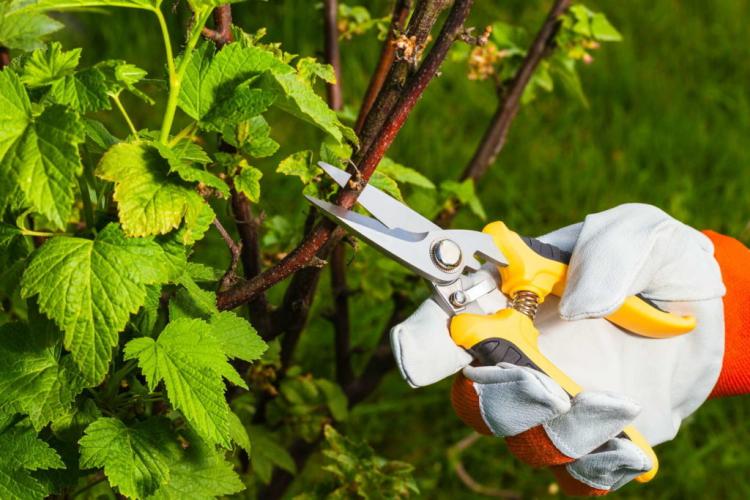
Cutting currants: when is the right time?
Currants are usually cut in the summer after they are harvested or before they sprout in February. In summer, the currant bush is sometimes also thinned out before harvest. This allows you to promote the formation of the flower buds on the remaining shoots through better exposure.
Cutting currants: instructions
When cutting the currants, you should pay attention to whether they are red, white, or black varieties. White and red currant varieties produce most of the fruits on the side shoots of the one to three-year-old main shoots. Shoots older than three years form only a few sides shoots with small fruits and must therefore be replaced by younger shoots. Black currants mainly bear fruit on annual shoots. With them, the growth of new, young shoots must be encouraged even more.
Cutting currants in a nutshell:
- For red and white currants, cut off all main shoots that are more than four to five years old. In the case of black currants, you can also prune back the annual shoots that have borne fruit this year.
- As a rule of thumb, between eight and twelve main shoots are ideal for the plant. Cut off any remaining, weak, inward-growing shoots.
- This step is particularly important for the red and white currants: In the eight to twelve shoots selected, the side shoots that have borne fruit this year are cut back to a stub on the main shoot. Up to eight of the newly grown side shoots are left per the main shoot. You should cut off the remaining (deeply attached, thin, steeply growing, drooping) side shoots directly on the main shoot.
- Also, remove sick and dry twigs.
- For red and white currants: For slow-growing varieties, shorten annual shoots by about a third. This improves branching, i.e. the formation of new side shoots.
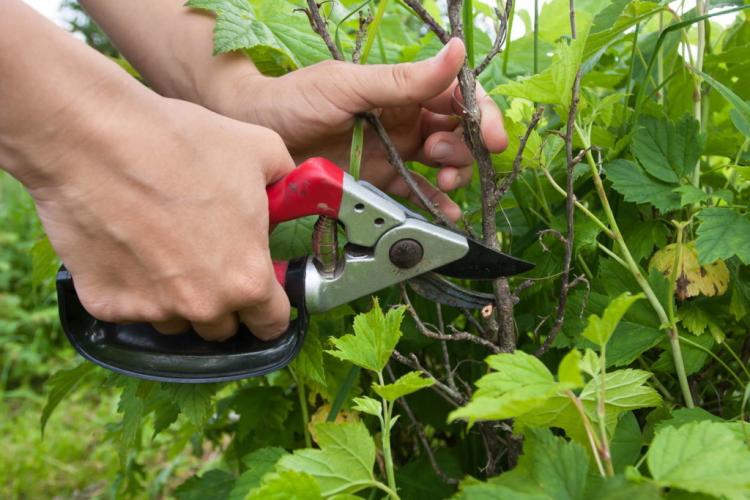
Harvesting currants: when is harvest time?
Depending on the variety, red and white currants usually ripen between June and August. Black currants begin to bear ripe fruit in July. When exactly the fruits are ripe for the picking, however, it is not that easy to determine. The berries take on their varietal color and become somewhat softer as they ripen. However, very soft fruits are often overripe and even fall off the bush. If you still feel resistance when plucking, you should wait a few more days. If the fruits come off easily, they are usually ripe. A sweet taste also suggests that it is ready for harvest.
Our tip: Only harvest on dry days, because wet fruits tend to rot. That is why we advise you to always wash the fruit immediately before eating or processing.
Currants can be stored in the refrigerator for a few days. However, they are healthiest when they are completely fresh when the light and heat-sensitive vitamin C is still present in its entirety. Because of their high proportion of fruit acid, currants are particularly suitable for making cakes, tarts, jams, and jellies.
Did you know that currants and gooseberries belong to the same family? We introduce you to the prickly relatives of the currant as well as helpful tips on cultivation and care.
